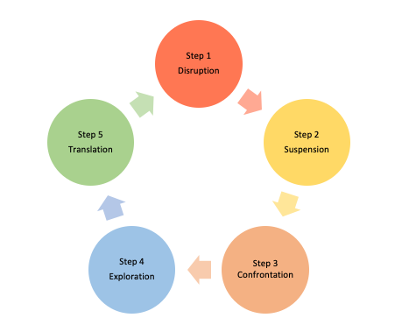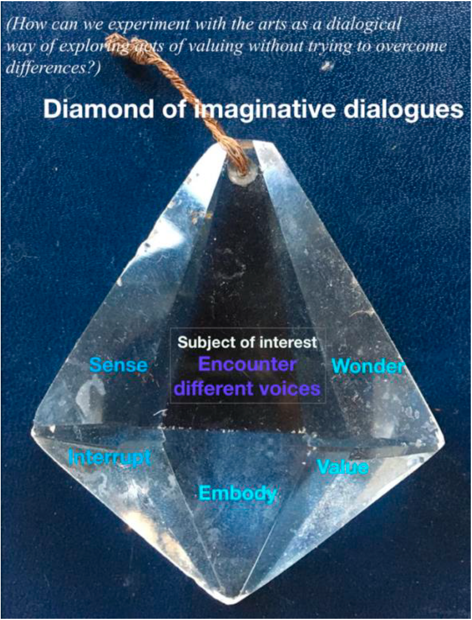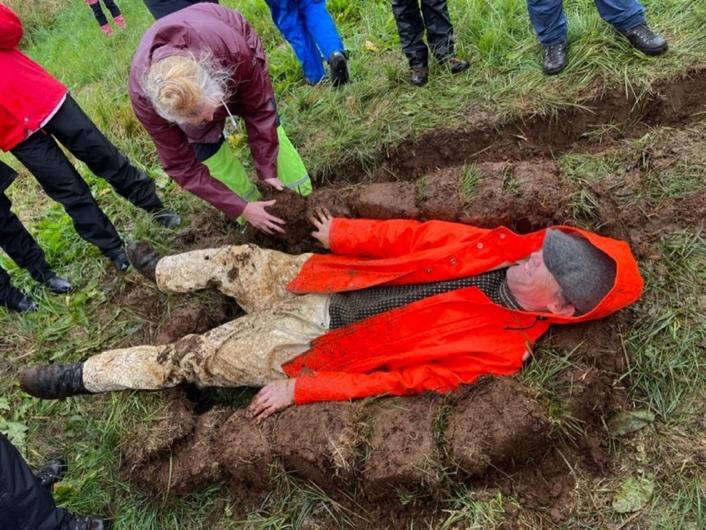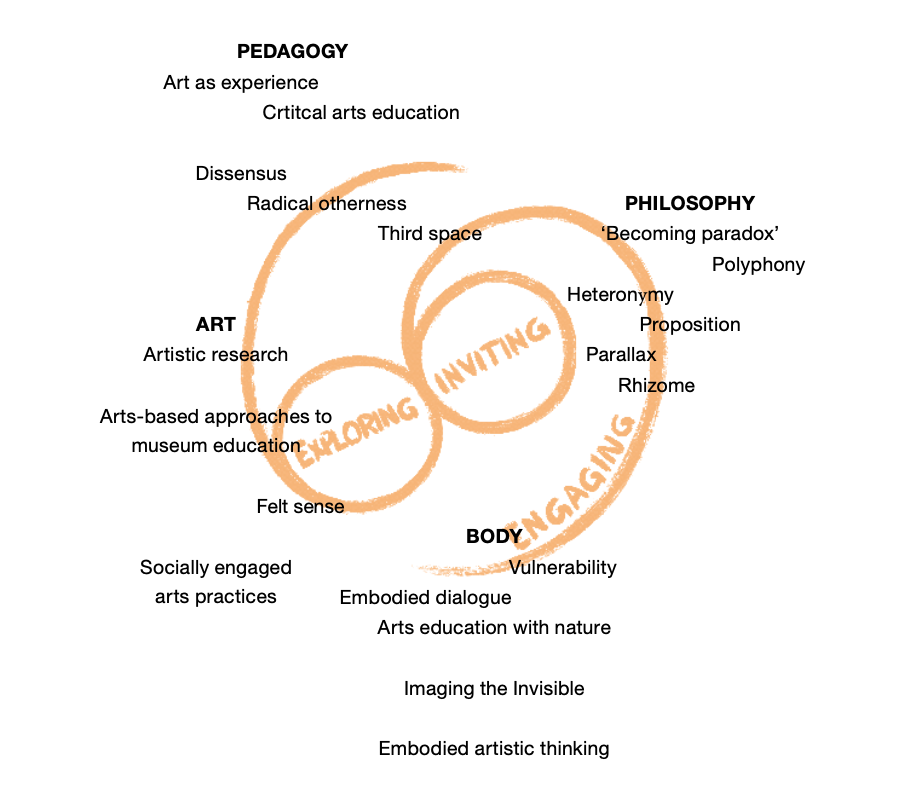PIMDI how and why – A methodological approach
Helene Illeris
Background
From the beginning of the project, PIMDI grew out of a shared concern among the partners regarding what we defined as ‘the paradox of democratization’ meaning that “stimulating diversity, democracy runs the risk of losing the common ground that allows for an interaction between perspectives” (application, p. 3). Thus, the intent behind the project was to use our common professional field, art education, to experiment with performative, embodied and imaginative arts-based approaches to dialogue in order to see if and how we could explore diversity in the act of valuing without losing our sense of togetherness. Through moving, sharing, listening, sensing, drawing, writing etc. we wanted to open new fields of dialogue, not by erasing differences, but by exploring them, trying to understand the underlying personal and cultural acts of valuing.
As partners, we came to the project with different theoretical, artistic, and pedagogical backgrounds and thus with different theoretical ideas and concepts. Although we shared a view on arts education as an explorative and open-ended practice, each of us brought unique methodological and theoretical perspectives arching from critical pedagogy over post structural, performative, and decolonial educational approaches, to new materialism and eco-art. However, and very much in accordance with PIMDI’s basic dialogical approach, we did not start the project by sitting down and discussing these differences, but rather, together with the participating students, we almost immediately began to enact them. In fact, one could say that the PIMDI methodology was never theoretical or methodological per se, but always grew out of very concrete proposals of how to do imaginative dialogue. Instead of describing, PIMDI is first and foremost a form of practice, a doing.
Notions, metaphors, and concepts
In order to better explain the how and why of PIMDI’s methodological thinking, we have chosen to distinguish between notions that are basic conceptual tools of PIMDI, metaphors that are the visual and physical materializations that we have used in order to design and develop research questions for each intensive week, and concepts that are the theoretical inputs from other theories that each partner has brought to the table. In the following we will explain and exemplify the PIMDI notions, metaphors, and concepts.
Notions
As shown in the PIMDI curriculum and tool box, PIMDI engages with some basic notions that remain with us when we plan and take part in PIMDI intensive weeks, and also when we work with PIMDI-related activities in our individual Master’s programmes. These notions are dialogue, imagination, difference, and valuing. The notions are not borrowed from specific theories but are the basic notions of a common arts-based methodological approach, designed out of the urgency to stimulate dialogue in an increasingly polarized European and global situation. Common to the four notions is that they were initially mentioned in the application for the project, and that their significance was continuously strengthened and enlarged through our practices throughout the project.
More concretely, the notions were incorporated in typical PIMDI activities through the learning movements of exploring, inviting, and engaging. In exploring for example, a space, a landscape, a movement, a narrative or different objects, imagination together with dialogue plays a central role. Through this initial exploration differences might appear, and the dialogue continues, though not in the form of a discussion but rather as an encounter and an interaction inviting the participants to embody or visualize the values that they are exploring. In the third learning movement, engaging, the notion of valuing becomes even more important as differences in the act of valuing that have appeared through imaginative dialogues are connected to urgent questions and to the participants’ own professional practices as (emergent) teachers and artists.
Metaphors
In the development of the PIMDI methodology, we adopted three different metaphors which were then explored as pedagogical approaches during the three intensive weeks in Helsinki (2021), Kristiansand (2022) and Reykjavik/Skalholt (2022). The three metaphors were the Circle, the Diamond, and the Turf. These metaphors should not be seen as abstract models or symbols, but rather as embodied, process-oriented materializations of experience based within pedagogical thinking as it permeates the space and time of pedagogy as active, ongoing processes. Although the order of the metaphors should not be strictly understood as a progression, they still indicate a process beginning with the Circle and ending with the Turf.

The Circle
The metaphor of the Circle was developed to reduce the complexity of ‘the pedagogy of imaginative dialogue’ and to give a quick overview, dividing the pedagogical method into five steps. As such, it could potentially be adopted both as a planning tool and as an analytical tool for a specific workshop or assignment.
We presented and explored the Circle during the first project period, including during the online intensive week in April 2021 and the intensive week in Helsinki in October 2021. As a metaphor, the Circle indicates a pedagogical thought process structured in five steps where one may jump from one step to another, thus creating a form of never-ending progression.
In practice, the Circle turned out to be very useful in understanding, discussions, and enactment of the basic notions of PIMDI, in particular regarding the notions of difference and imagination and how these could be integrated through exercises, group work and presentations. Still, by indicating an abstract, immaterial movement, the Circle was not capable of capturing the more physical, embodied, affective, and often chaotic and apparently contradictory aspects of how exploring, inviting, and engaging unfolded in practice.

The Diamond
The metaphor of the Diamond was developed for the second Intensive week, taking place in Kristiansand, Norway. We proposed it because it is multi-faceted, thus giving way to simultaneity instead of progression. With these traits in mind, we focused on PIMDI as the encounter of different voices, opening more explicitly for polyphony and paradox as central to the pedagogy of imaginative dialogue. As a metaphor, the Diamond is more physically present than the Circle because we all have experiences with cut glass – both with how it looks and feels when touched, and with how it works as a prism, reflecting light in many directions, giving rise to surprising ‘rainbows’ and other natural phenomena. In practice, we (the teachers) asked the students to draw their own diamonds and to develop these drawings (e.g., through writing and further drawing) during the whole week, ending up with a whole wall of drawings, writings, and other interventions.

The Turf
The metaphor of the Turf was used in the development of the intensive week in Iceland. When considering the metaphor from the realm of physics, diamonds and turf share carbon as their basic molecular elements though they are obviously very different in appearance. While a diamond is hard and smooth and reflects light in a polyphony of ‘voices’, the turf is a soft, humid and absorbing form of existence with no clear beginnings and endings. Turf is a layering of natural materials, composed of tiny yet strong interwoven bog plant roots and wet soil, and it is used as a building material for traditional Icelandic houses. Turf is a rhizome, and within PIMDI it became a metaphor for how our polyphonic voices often appear as intertwined and impossible to separate, and thus relevant to the creation of new and unseen creative events.
In Skalholt, Iceland we explored imaginative dialogues with other-than-human forms of beings in nature and, among other things, we dogged turf in the rain, we made pictures with nature, and we sang and moved together on the grass. Finally, we offered some of these experiences to pupils from a local boarding school who showed us their interpretations of imaginative dialogues with nature.
Concepts
During the project period a number of theoretical concepts were brought to the table by the researchers/teachers in relation to the PIMDI activities. Many of these concepts were introduced in relation to practice and different perspectives on imaginative dialogue. The concepts can thus be used to highlight specific aspects of the notions and metaphors. For example, one of the 20 concepts, embodied dialogue indicates an important aspect of the notion of dialogue and is explained by Eeva Antilla through Martin Buber’s philosophy on the relational and nonverbal foundation of human existence. Another concept, polyphony, was used throughout the project to indicate the many different voices present in the dialogue and is explained by Nathalie Beekman through the theories of M. M. Bakthin and Hermans & Hermans-Konopka.
All of the PIMDI concepts are presented in the theoretical sheets. Here you can find short presentations of 20 concepts with examples of how they have been used in practice and with explanations of their relevance to the PIMDI pedagogy. We have chosen to put the concepts in alphabetical order because we see each of them providing theoretical inspiration in their own unique way. However, as illustrated in the drawing below, one could point to certain ‘clusters’ of concepts belonging together more than others. The clusters should thus be seen as pragmatic examples more than ‘truths’ about how the concepts could be grouped. The clusters, as grouped together below, are inspired by the headlines of pedagogy, art, body and philosophy.

Methodology: PIMDI as an explorative space of dialogue through arts education
In PIMDI, theory and practice is always woven together in embodied forms of doing. Thus, the methodology cannot be described as a series of predefined steps leading to certain outcomes. Quoting Irit Rogoff, one could say that methodologically a pedagogy of imaginative dialogue is always “starting in the middle”, with a concrete situation taking place in a concrete space, including living embodied persons, objects, sounds, light, smells etc. As indicated by the metaphors, PIMDI is circular, polyphonic and rhizomatic, it moves in three dimensions, it is always in progress or expansion, one never knows where it will end.
Helene Illeris would like to acknowledge that the work described here represents the collaboration of many minds of students and teachers from the PIMDI project from 2020 to 2023. In particular Illeris wishes to express her gratitude to ‘IO2 members’ who, together with her, were Nathalie Beekman, Taneli Turovinen, and Ingimar Ólafsson Waage.
Concepts
